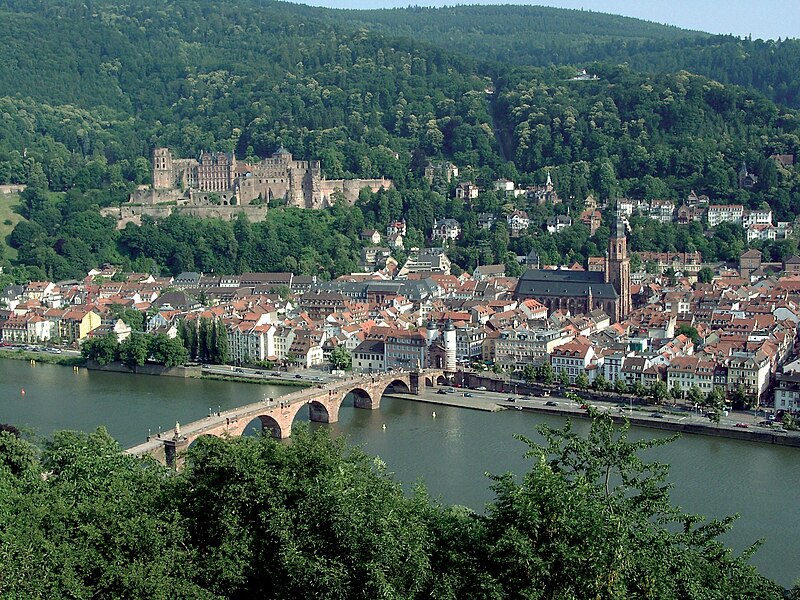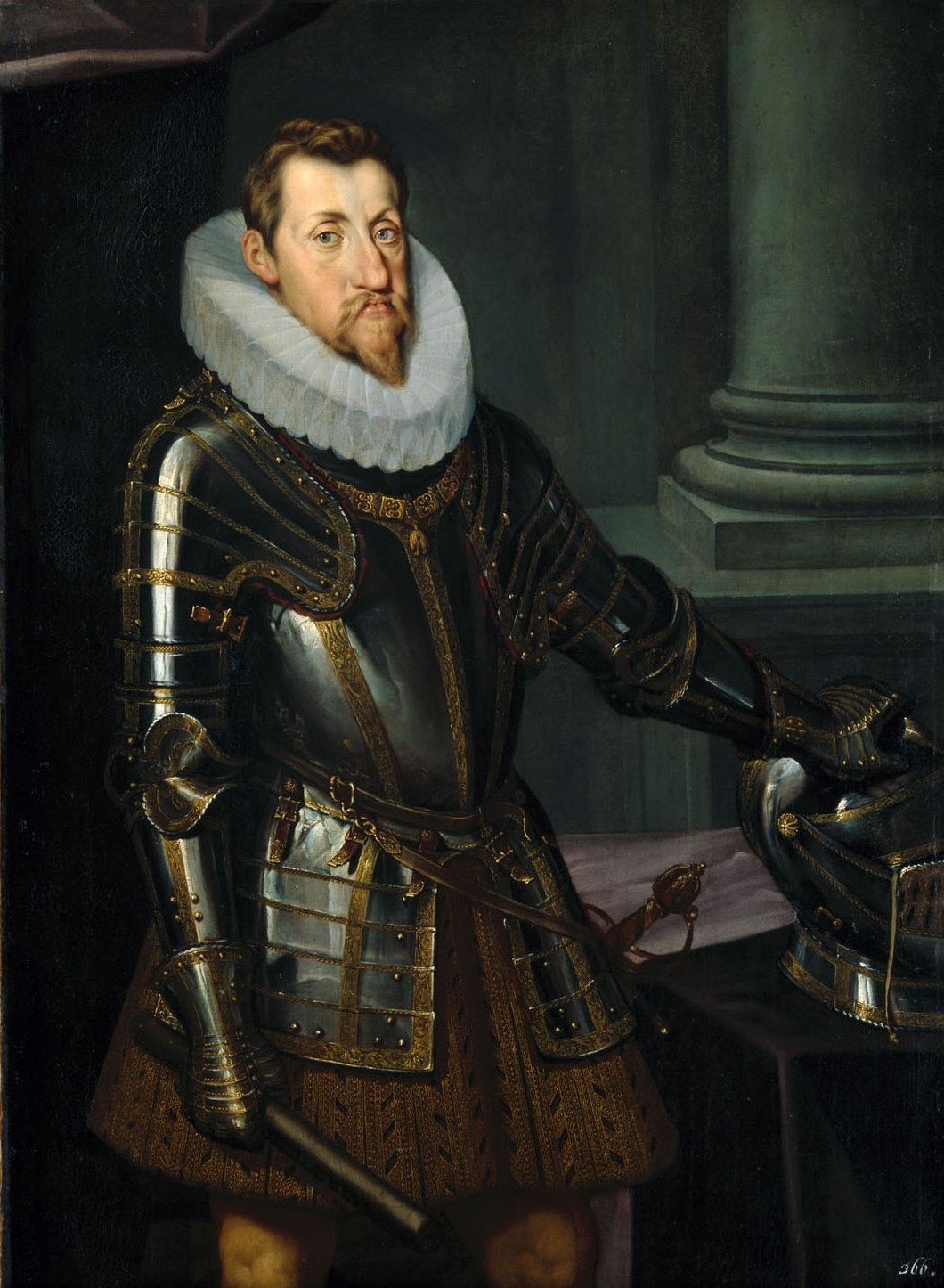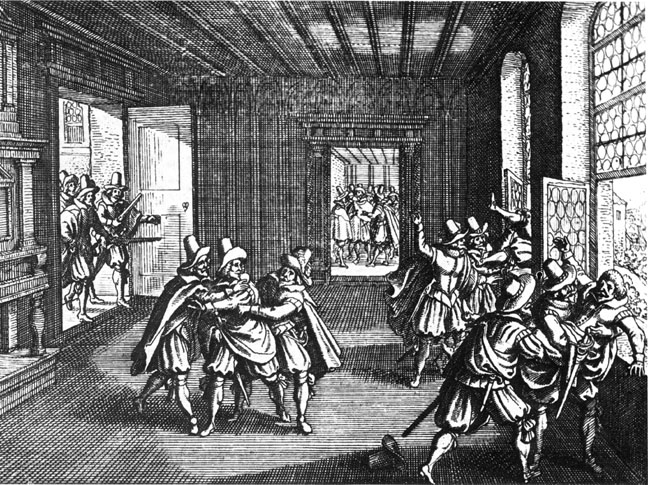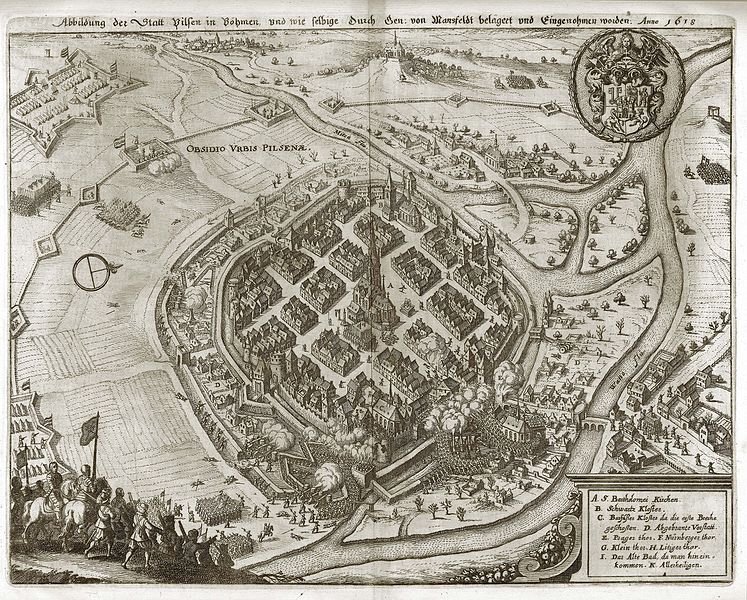 |
| Elizabeth |
Arrival in a Foreign Land
In April, escorted
by Lord and Lady Harington and their niece Anna Sutton-Dudley[i], the Duke of Lennox[ii], the Earl and Countess of Arundel and Sir Edward Cecil, Frederick and Elizabeth journeyed to Frederick’s
homeland. A fleet of seven ships commanded by the Lord High Admiral escorted
the happy couple from Margate to Flushing, where the newlyweds were met by Prince Maurice[iii].
The bridal
party travelled on to den Haag, Leyden, Haarlem and during the journey Elizabeth met
with an emissary of the Infanta Isabella, ruler of the Spanish Netherlands. On 13th May they arrived in Amsterdam where the company were royally entertained. On 22nd Elizabeth
met George William, the Elector of Brandenburg; the
following day he escorted the party to Düsseldorf. Here the party transferred to a small fleet of boats and
travelled up the Rhine.
T
hey finally
arrived in Frederick’s domains at Oppenheim and thence travelled on to the castle at Frankenthal[iv].
 |
| Louise Juliana van Oranje |
‘Every house was crowned
with a garland; the air breathed fragrance, and from every quarter resounded
songs of gladness.’[v]
The party,
after much pageantry and display, then travelled on to Heidelberg where Elizabeth and her escort passed under a number of
triumphal arches before reaching the castle. Among those there to greet Elizabeth were the Dowager Duchess of Zweibrucken, Frederick’s mother Juliana[vi] and Frederick’s sisters.
The Sound of Distant Drums
On the 1st
January 1614 Elizabeth gave birth to a son she named Henry Frederick. The young Prince Henry was
christened in Heidelberg, presumably at the Church of the Holy Spirit[vii]. He was carried in church by his
aunt Katherina Sofie. Henry was the first of thirteen children, the last of
whom, Gustavus Adolphus[viii], was born in 1632.
 |
| Heidelberg |
Spain had an
interest in German affairs arising from their holdings in the Spanish
Netherlands [ix] . And Philip III wanted
access to and control of the Rhine to enable the passage of troops from
northern Italy to the Spanish Netherlands. In turn the Holy Roman Emperor Matthias, looked to his cousin Philip for
support against his rebellious Protestant Electors.
Sweden,
under the expansionist rule of Gustavus Adolphus, and Denmark were both
interested in expanding their influence in the Baltic region and France felt in danger of Hapsburg encirclement, with Spain to the south and the Holy Roman Empire to the north. The individual German states had
differing alliances and these and the question of religion were tearing the Holy
Roman Empire apart.
Divided by Religion
 |
| Matthias |
As leader of
the most flourishing state, Frederick saw himself as the head of the Protestant Union, a grouping of the German Protestant states. The opposing
German Catholic League, was headed by his cousin Maximilian of Bavaria.
When the
Duchy of Cleves-Jülich came up for grabs in 1610, the Protestant Union was anxious
to prevent it falling to a Catholic candidate; both candidates were Protestants.
The emperor took the Duchy under his control; a move which was viewed with
concern by the Protestant lords, who thought that Matthias was intending to add
Cleves-Jülich to the already enormous Hapsburg holdings; thus increasing
Protestant forebodings.
On 20th
March 1619 Matthias died and his successor was Ferdinand II. Ferdinand had or already been
chosen as Matthias’s successor as the King of Bohemia in 1617[x], the following year he was
elected King of Hungary. As a devout Catholic, Ferdinand was heavily involved
in the opposition to the Protestant Union.
The Thirty Years’
War
Begins
 |
| Ferdinand II |
The Second Defenestration of Prague was the start of a Protestant rebellion in Bohemia. It was also the spark that lit the conflagration of the Thirty Years’ War
which dragged in most of northern and central Europe. Ferdinand, as King of
Bohemia, was determined to reduce the powers of the Protestant lords in Bavaria.
He had persuaded Matthias to agree to stop the building of Protestant churches
on royal land, as allowed by the Letter of Majesty[xi] which gave the Protestants their
religious freedoms.
The Bohemian
estates protested and Ferdinand dissolved the assembly and imprisoned some of
the burghers of Braunau[xii]. The Lords Regent[xiii] were confronted by the
Protestant lords led by Count Thurn[xiv] at Hradschin Castle on 23rd May 1618
 |
| Defenestration of Prague |
‘His
Imperial Majesty had sent to their graces the lord regents a sharp letter…….in
which His Majesty declared all of our lives and honour already forfeit, thereby
greatly frightening all three Protestant estates……we wish to know, and hereby
ask the lord regents present, if all or some of them knew of the letter,
recommended it, and approved of it.’’[xv]
The
Protestant Lords demanded the freeing of the prisoners and when their demands
were not met the two Lords Regent considered the ring leaders, Count Slavata and Count Borzita, were thrown out of the council
chamber window along with the secretary Philip Fabricius; all three men survived the seventy foot drop to the
ground, which was immediately announced to be a miracle.
King of Bohemia
 |
| Siege of Pilsen |
At this
point Frederick’s governor of the Upper Palatinate, and chief adviser Christian, Prince of Anhalt-Bernberg, intervened in Bohemian affairs. In August 1618 Frederick’s
general, Ernst von Mansfeld led an expeditionary force into
Bohemia to assist the rebels and once there successfully directed the Siege of Pilsen. He was given command of the Bohemian troops.
The
following year the Bohemian rebels offered Frederick the crown of Bavaria after
John Georg the Elector of Saxony, had turned it
down. After much misgivings he decided to accept. Frederick thought that he
would be better placed as King of Bohemia to safeguard princely liberties from
infringement by the emperor and his cohorts.
 |
| Battle of Sablat |
Frederick’s
decision to accept Bohemia, and jealousy of his young cousin, prompted Maximilian
of Bavaria, master of one of the most professional armies in Europe, to come to
an agreement with Ferdinand. He would support Ferdinand, take control of any
lands he conquered and once Frederick was defeated Maximilian would become
Elector of the Palatinate.
On 10th
June 1619 the Catholics won the Battle of Sablat and shortly thereafter Ferdinand was elected emperor[xvi]. At the end of July Lusatia, Silesia and Moravia signed the terms of a joint confederation with Bohemia. And then Bethlen Gabor, the Protestant Prince of Transylvania, with the support of the Ottoman emperor Osman II[xvii], invaded Hungary and Ferdinand’s
Protestant subjects flocked to Gabor’s side. On 20th August he and
Count Thurn signed an offensive and defensive alliance.
 |
| Frederick as King of Bohemia |
Following
Frederick’s coronation on 3rd November, a heavily pregnant
Elizabeth, having braved the arduous journey to Prague, was crowned on 6th.
Her show of courage made a very favourable impression on her husband’s new
subjects. Although Frederick was to learn soon enough that there was no money
to pay for an army, the streets of Prague were decked with hangings of blue and
silver.
On 17th
December 1619 Elizabeth gave birth to her third son Rupert[xviii]. She had been hurt by her mother’s
death earlier in the year on 2nd March. Anne had left Elizabeth
nothing in her will;
‘She bequeathed no part of
her property, nor even one of those superb jewels.’[xix]
Elizabeth kept
up her correspondence with her father, but James did not approve of her and
Frederick’s rashness and refused to refer to his son-in-law as king.
Bibliography
Gustavus
Adolphus the Great – Nils Ahnlund, 1999 History Book Club
Memoirs of
Elizabeth Stuart, vols 1 & 2 – Elizabeth Benger (ed), General Books LLC
2012
The Early
Stuarts – Godfrey Davies, Oxford University Press 1987
King James –
Antonia Fraser, BCA 1974
Charles I –
Christopher Hibbert, Penguin 1968
The Thirty
Years War – Herbert Langer, Dorset Press 1990
The Thirty
Years War – CV Wedgewood, Folio Society 1999
[i]
On this trip Anna met the Count von
Schönberg,
Frederick’s hofmeister,
and they were married two years later
[iv]
Later a centre of silk and porcelain manufacture
[v]
Memoirs of Elizabeth Stuart – Berger (ed)
[vii]
The church were the Electors were buried
[viii]
Named by Elizabeth in direct opposition to Friedrich, who wished to name the
child after his lost Henry Frederick.
[ix]
In 1609 Philip III had signed an armistice granting the Dutch in the United
Provinces independence and immunity from attack for 12 years. The southern
Netherlands was ruled from Brussels by the Infanta Isabella. But the Spaniards
had always planned to retrieve their lost territories and spent the period
preparing to reconquer the United Provinces.
[x]
For want of an acceptable Protestant candidate
[xiii]
Governors appointed by Frederick, all Catholic
[xvi]
There was no other candidate capable of the role
[xvii]
Transylvania was part of the Ottoman Empire
[xviii]
Known to history as Rupert of the Rhine, commander of the royalist cavalry
during the English Civil
War. He also served Louis XIV and later
for his cousin Charles
in the Anglo Dutch wars
as a naval commander
[xix]
Memoirs of Elizabeth Stuart – Berger (ed)
No comments:
Post a Comment
Note: only a member of this blog may post a comment.